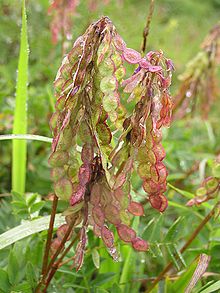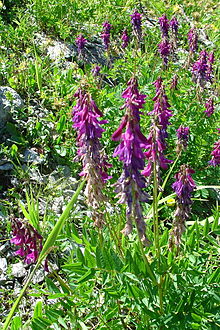Alpine sweet clover
| Alpine sweet clover | ||||||||||||
|---|---|---|---|---|---|---|---|---|---|---|---|---|

Alpine sweet clover ( Hedysarum hedysaroides ) |
||||||||||||
| Systematics | ||||||||||||
|
||||||||||||
| Scientific name | ||||||||||||
| Hedysarum hedysaroides | ||||||||||||
| ( L. ) Schinz & Thell. |
The alpine sweet clover ( Hedysarum hedysaroides ) is a species of the sweet clover ( Hedysarum ) genus within the legume family (Fabaceae).
description
Vegetative characteristics
The Alpine sweet clover grows as a deciduous, perennial herbaceous plant and reaches heights of 10 and 30 centimeters. The taproot is often meters long. The simple, upright stems are angular.
The leaves are pinnate unpaired, with 9 to 21 sessile leaflets . The leaflets are lanceolate with a length of 10 to 30 millimeters. The stipules are membranous, brown and fused to over the middle.
Generative characteristics
The flowering period extends from June to August. 10 to 50 nodding flowers sit in a one-sided racemose inflorescence .
The hermaphrodite flowers are zygomorphic and five-fold with a double flower envelope . The five sepals are fused together like a bell. The red-violet petals form a 15 to 20 millimeter long crown with the typical shape of the butterfly flower . The shuttle is longer than the wing and flag.
The fruits are flat pods that do not open, but instead disintegrate into individual slices.
The number of chromosomes is 2n = 14.
Occurrence
The distribution area of the Alpine sweet clover in Europe includes the Alps and Pyrenees up to the Carpathian Mountains , plus the Russian Arctic and the northern and central Urals. It shows the typical distribution of glacial relic species with arcto-alpine disjunction . In the Central European Limestone Alps it occurs scattered; in areas with lime-poor rock it is rare in Central Europe . In Austria it occurs scattered to often except for Vienna and Burgenland . On the Balkan Peninsula, the occurrence is limited to the eastern Prokletije . Here it is common in 2000 to 2400 meters.
The Alpine sweet clover thrives at altitudes of 1000 to 3000 meters, but in Central Europe it prefers altitudes between 1800 and 2500 meters. In the Allgäu Alps, it climbs up to an altitude of 2383 meters at the Rauheck summit in Bavaria.
The alpine sweet clover populates sunny , poor grasslands , wild haylage . Rock bands, uneven lawns as well as mats and loose dwarf shrub stands . The alpine sweet clover thrives on loose, stony loam soils in an alpine location; it prefers calcareous soils , but it also goes on low-lime subsoil if it is rich in nutrients . It is a character species of the order Seslerietalia, but also occurs in the Elynetum from the Elynion association .
Ecology and use
The alpine sweet clover has root nodules with nitrogen-fixing bacteria .
It is attacked by the rust fungus Uromyces hedysari-obscuri with spermogonia , aecidia and telia .
Alpine sweet clover is one of the most valuable Alpine forage crops with a high protein and fat content . Although slightly bitter, it is eagerly eaten by cattle, but does not tolerate heavy grazing; it is better suited for hay extraction ( mowing ).
Systematics
It was first published under the name ( Basionym ) Astragalus hedysaroides in 1753 by Carl von Linné . The new combination to Hedysarum hedysaroides (L.) Schinz & Thell. was published in 1913 by Hans Schinz and Albert Thellung . The specific epithet hedysaroides means "similar to sweet clover".
Depending on the author, there are two or three subspecies of the species Hedysarum hedysaroides :
- High Alpine sweet clover ( Hedysarum hedysaroides subsp. Exaltatum (A.Kerner) Žertová , Syn .: Hedysarum exaltatum A.Kerner ): Its growth is 30–40 centimeters higher than the other forms; each leaf has 6–10 pairs of leaflets; the longest calyx teeth are 3–4.5 millimeters long. It occurs in the Southern Alps.
- Common Alpine sweet clover ( Hedysarum hedysaroides (L.) Schinz & Thell. Subsp. Hedysaroides ): With a stature height of 10-15 centimeters, this subspecies is lower than the other forms; each leaf has only 4–6 pairs of leaflets; the longest calyx teeth are 1.5–3 millimeters long. It occurs in almost the entire area of the species.
- Arctic Alpine Sweet Clover ( Hedysarum hedysaroides subsp. Arcticum (B.Fedtsch.) PWBall , Syn .: Hedysarum arcticum B.Fedtsch. ): This subspecies, which some authors consider to be a separate species, reaches heights of 20–30 Centimeters; each leaf has 4–6 pairs of leaflets and the longest calyx teeth are about 1.5 millimeters long. It occurs in Europe only in arctic Russia and in the northern and central Urals.
literature
- Xaver Finkenzeller, Jürke Grau: Alpine flowers. Recognize and determine (= Steinbach's natural guide ). Mosaik, Munich 2002, ISBN 3-576-11482-3 .
- Wolfgang Adler, Karl Oswald, Raimund Fischer: Excursion flora of Austria . Ed .: Manfred A. Fischer. Eugen Ulmer, Stuttgart / Vienna 1994, ISBN 3-8001-3461-6 .
Individual evidence
- ↑ Hedysarum hedysaroides (L.) Schinz & Thell., Alpen-Süßklee. In: FloraWeb.de.
- ↑ a b Erich Oberdorfer : Plant-sociological excursion flora for Germany and neighboring areas. 8th edition. Stuttgart, Verlag Eugen Ulmer, 2001, ISBN 3-8001-3131-5 . Page 606.
- ↑ a b c d Dietmar Aichele, Heinz-Werner Schwegler: The flowering plants of Central Europe . 2nd Edition. tape 2 : Yew family to butterfly family . Franckh-Kosmos, Stuttgart 2000, ISBN 3-440-08048-X .
- ↑ Snežana Vukojičić 2009: Glacijalni relikti u orofitskoj flori Srbije, Crne gore i Makedonije. Dissertation, University of Belgrade, Faculty of Biology (Univerzitet u Beogradu, Biološki Faculty).
- ↑ Erhard Dörr, Wolfgang Lippert : Flora of the Allgäu and its surroundings. Volume 2, IHW, Eching 2004, ISBN 3-930167-61-1 , p. 149.
- ↑ Peter Zwetko: The rust mushrooms Austria. Supplement and host-parasite directory to the 2nd edition of the Catalogus Florae Austriae, III. Part, Book 1, Uredinales. (PDF; 1.8 MB).
- ↑ Günther Blaich: data sheet with photos.
- ↑ A. Chrtková-Žertová: Hedysarum L. In: Thomas Gaskell Tutin et al .: Flora Europaea . Volume 2, pages 185-187. Cambridge University Press 1968.
- ↑ David Aeschimann, Konrad Lauber, Daniel Martin Moser, Jean-Paul Theurillat: Flora alpina. An atlas of all 4500 vascular plants in the Alps . Volume 1, page 950. Haupt Verlag, Bern, Stuttgart, Vienna 2004, ISBN 3-258-06600-0 .
Web links
- Hedysarum hedysaroides subsp. hedysaroides (L.) Schinz & Thell., Alpine sweet clover. In: FloraWeb.de.
- Alpine sweet clover . In: BiolFlor, the database of biological-ecological characteristics of the flora of Germany.
- Profile and distribution map for Bavaria . In: Botanical Information Hub of Bavaria .
- Hedysarum hedysaroides (L.) Schinz & Thell. In: Info Flora , the national data and information center for Swiss flora . Retrieved November 21, 2015.
- Thomas Meyer: Data sheet with identification key and photos at Flora-de: Flora von Deutschland (old name of the website: Flowers in Swabia ).
- Gerhard Nitter: Profile with photos.



